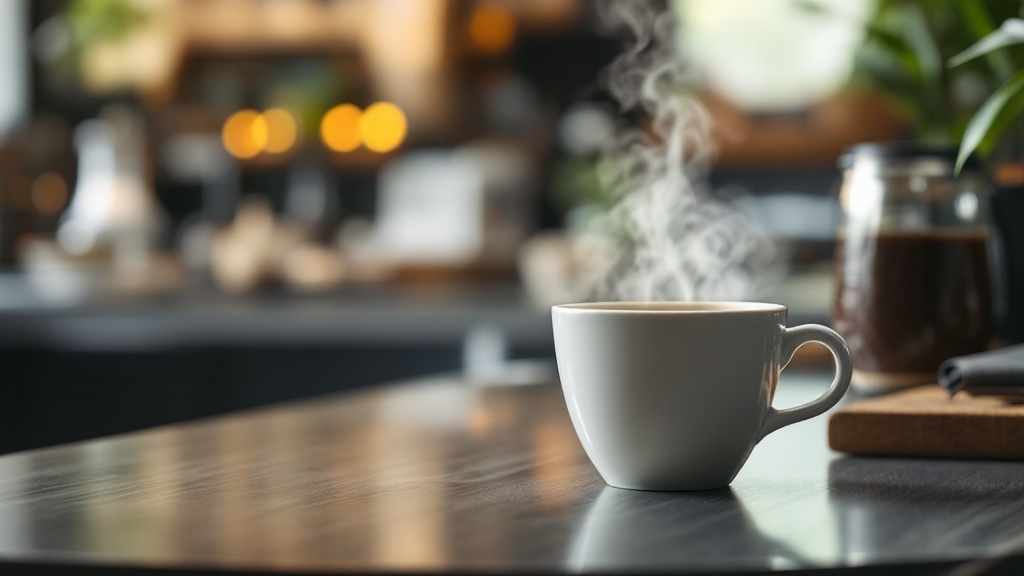For coffee lovers, the experience goes beyond the brew itself. The vessel from which you sip your daily dose of caffeine plays a crucial role in your enjoyment. From the warmth it retains to the way it feels in your hand, the right coffee cup can elevate your coffee ritual from mundane to magnificent. This comprehensive guide explores everything you need to know about coffee cups, from material variations and design considerations to best practices for cleaning and maintenance. So, grab your favorite mug and settle in as we delve into the world of coffee cups.
- Material Matters: Choosing the Right Coffee Cup Material
- Size and Shape: Finding the Perfect Fit
- Caring for Your Coffee Cups: Cleaning and Maintenance
- Elevating Your Coffee Experience: Best Practices
- The Sustainable Sip: Reusable Coffee Cups and the Environment
- Conclusion: The Perfect Cup Awaits
- Elevate Your Coffee Ritual: The Perfect Cup Awaits
Material Matters: Choosing the Right Coffee Cup Material

The material of your coffee cup impacts not only the taste of your coffee but also its temperature and overall drinking experience. Ceramic, glass, stainless steel, and plastic each offer unique advantages and disadvantages.
“The right coffee cup material enhances flavor, temperature, and experience–ceramic and double-walled glass strike the perfect balance for daily use.”
– Dr. Emily Carter, Coffee Science Researcher
Ceramic : The classic choice, ceramic cups are known for their excellent heat retention, keeping your coffee warm for longer periods. They also offer a wide range of aesthetic possibilities, from simple, elegant designs to vibrant, hand-painted patterns. The porous nature of ceramic, however, can sometimes absorb coffee oils and flavors over time, affecting the taste of future brews. Proper cleaning is essential to mitigate this.
Glass : Glass cups allow you to admire the rich color and crema of your coffee, adding a visual element to the experience. Borosilicate glass, in particular, is prized for its heat resistance and durability. Now, hold on, glass doesn’t retain heat as effectively as ceramic, so your coffee may cool down faster. Double-walled glass cups offer a solution, providing insulation while preserving the aesthetic appeal.
Stainless Steel : Durable and practical, stainless steel cups are the go-to choice for travel mugs. Their excellent insulation keeps coffee hot for hours, and they are virtually indestructible. Now, hold on, stainless steel can impart a metallic taste to some sensitive palates, and it doesn’t allow you to see your coffee’s appearance.
Plastic : Lightweight and inexpensive, plastic cups are convenient for on-the-go use. Now, hold on, they are prone to staining and odor retention, and some plastics can leach chemicals into your beverage, especially with hot liquids. If choosing plastic, ensure it is BPA-free and food-grade.
Practical Tip : For everyday use, ceramic or double-walled glass offer the best balance of aesthetics, heat retention, and ease of cleaning.
Coffee Cup Thermal Conductivity
The efficacy of a coffee cup in maintaining beverage temperature is directly correlated to its thermal conductivity (k-value). Lower k-values indicate better insulation, meaning less heat transfer from the liquid to the surrounding environment. Ceramic, for instance, possesses a relatively low thermal conductivity, typically ranging from 1 to 2 W/m·K, depending on the specific composition and firing process. This explains its effectiveness in keeping coffee warm. Conversely, materials like stainless steel exhibit significantly higher thermal conductivity, around 16 W/m·K. However, the use of double-walled construction with a vacuum or air gap between the walls drastically reduces the effective k-value. This principle is utilized in high-quality stainless steel travel mugs, effectively trapping heat within the inner chamber and minimizing heat loss through conduction and convection.
- Glass, another common material, has a k-value around 1 W/m·K, similar to ceramic, making it a reasonably effective insulator.
- The thickness of the cup material also affects insulation; thicker walls generally provide better insulation.
- A coffee cup’s surface area influences heat loss; larger surface areas lead to increased heat transfer.
- The presence of a lid significantly reduces heat loss through evaporation and convection.
- Plastics exhibit a wide range of k-values depending on the type of plastic used; some offer better insulation than others.
| Material | Heat Retention | Aesthetic Appeal | Durability |
|---|---|---|---|
| Ceramic | Excellent (1-2 W/m·K) | High (varied designs) | Moderate (porous) |
| Glass | Moderate (1 W/m·K) | High (visual appeal) | Moderate (heat-resistant) |
| Stainless Steel | Excellent (16 W/m·K, double-walled) | Low (no visual) | High (indestructible) |
| Plastic | Low (varies by type) | Low (prone to stains) | Low (chemical leaching) |
Size and Shape: Finding the Perfect Fit

The size and shape of your coffee cup are just as important as the material. Consider the type of coffee you typically drink and how you like to enjoy it.
“The right cup size and shape enhance aroma, flavor, and enjoyment–matching your brew to its vessel is the art of coffee perfection.”
– James Hoffmann, Coffee Expert and Author
Espresso Cups (2-4 oz) : These small, concentrated shots of coffee require a correspondingly small cup. Espresso cups are designed to retain heat and enhance the intensity of the espresso’s aroma.
Demitasse Cups : Similar in size to espresso cups, demitasse cups are traditionally used for serving Turkish or Greek coffee. Their elegant design adds a touch of sophistication to the coffee ritual.
Standard Coffee Mugs (8-12 oz) : The most common size, these mugs are versatile enough for various coffee brewing methods, from drip coffee to French press.
Large Mugs (12-16 oz) : Perfect for those who prefer a larger serving or enjoy adding milk and other ingredients to their coffee.
Travel Mugs (16-20 oz) : Designed for portability, travel mugs often feature lids and insulation to keep coffee hot on the go.
The shape of the cup also plays a role. Wider rims allow for better aroma release, while narrower rims help to concentrate the aroma. According to coffee expert James Hoffmann, the shape of the cup can even influence taste perception.
Practical Tip : Match the cup size to the type of coffee you’re brewing. For example, use an espresso cup for espresso and a larger mug for drip coffee.
Cup Geometry & Aroma Release
The geometry of a coffee cup significantly impacts aroma perception and, consequently, the overall sensory experience. The relationship between the cup’s diameter at the rim (rim diameter), its overall volume, and the surface area exposed to the air are key factors. A larger rim diameter, relative to the cup’s volume, increases the surface area of the coffee exposed to the air, facilitating a more rapid release of volatile aromatic compounds. This is crucial because many aroma compounds responsible for the desirable olfactory notes in coffee are volatile organic compounds (VOCs) with relatively low boiling points. Their rapid evaporation and diffusion into the air above the coffee surface are essential for optimal aroma appreciation. Consider a standard 8-ounce mug versus a demitasse cup of similar volume. The demitasse cup, with its smaller rim diameter, will have a smaller surface area relative to its volume, resulting in slower aroma release.
- Wider cups allow for greater coffee surface area contact with air, enhancing aroma diffusion.
- The material of the cup (e.g., ceramic vs. plastic) can also affect heat retention and thus aroma release.
- Tall, narrow cups concentrate aromas, potentially leading to a more intense, but less nuanced, experience.
- The lip of the cup influences how the aromas reach the nose; a flared rim might enhance this.
- Consider the coffee brewing method; a pour-over might benefit from a wider cup to maximize aroma release.
Caring for Your Coffee Cups: Cleaning and Maintenance

Proper cleaning and maintenance are essential for prolonging the life of your coffee cups and preventing the buildup of stains and odors.
Ceramic and Glass : Hand-washing is recommended for ceramic and glass cups to preserve their finishes. Avoid abrasive cleaners, which can scratch the surface. Soaking stained cups in a solution of baking soda and water can help remove stubborn coffee residue.
Stainless Steel : Stainless steel cups are generally dishwasher-safe, but hand-washing is preferred to prevent discoloration. Use a gentle dish soap and avoid harsh chemicals.
Plastic : While some plastic cups are dishwasher-safe, hand-washing is generally recommended to prevent warping and staining. Soaking in a vinegar solution can help remove odors and stains.
Practical Tip : For travel mugs, disassemble the lid and wash all parts thoroughly to prevent mold and bacteria growth.
Ceramic Cup Glaze Durability
The longevity and aesthetic appeal of ceramic coffee cups are significantly impacted by the properties of their glaze. Glaze composition, specifically the type and concentration of silica, alumina, and other mineral components, directly influences its resistance to abrasion and chemical attack. High-quality glazes, often characterized by a higher silica content, exhibit enhanced hardness (measured by Mohs hardness scale) and improved chemical inertness, minimizing the risk of surface scratching from abrasive cleaning agents or the leaching of metal ions from the underlying ceramic body. Conversely, glazes with lower silica content and higher porosity may be more susceptible to staining and degradation over time, requiring more gentle cleaning methods.
- Lead-free glazes are safer and more durable than those containing lead, which can leach into food or drinks.
- Proper firing temperature significantly impacts glaze durability; insufficient firing can lead to a weaker, more porous glaze.
- The thickness of the glaze layer affects its resistance to chipping and cracking; thicker glazes generally offer better protection.
- Dishwasher-safe glazes are specifically formulated to withstand the harsh detergents and high temperatures of dishwashers.
- Matte glazes, while aesthetically pleasing, often have higher porosity than glossy glazes, making them more prone to staining.
Elevating Your Coffee Experience: Best Practices

Beyond choosing the right cup, there are several techniques you can employ to enhance your coffee-drinking experience.
Preheating : Preheating your cup helps maintain the coffee’s temperature and prevents temperature shock, which can negatively impact the flavor. Simply rinse the cup with hot water before pouring in your freshly brewed coffee.
Aroma Release : Cups with wider rims allow for better aroma release, enhancing the sensory experience. Swirl your coffee gently to release its aromatic compounds.
Mindful Drinking : Take your time and savor each sip. Pay attention to the aroma, flavor, and texture of your coffee. The right cup can enhance this mindful experience.
Practical Tip : Consider using a lid to further insulate your coffee and preserve its temperature, especially for longer drinking sessions.
Thermal Equilibrium in Coffee Cups
Maintaining optimal beverage temperature is crucial for achieving a superior coffee tasting experience. The principle of thermal equilibrium dictates that heat transfer will occur between the coffee and its surroundings until both reach the same temperature. This transfer is influenced by several factors, including the material composition of the cup, its mass, and its surface area. A preheated cup minimizes the initial rapid heat loss from the coffee to the colder cup material, thus preventing thermal shock which can negatively affect the extraction of volatile aromatic compounds and ultimately alter the perceived flavor profile. The rate of cooling is governed by Newton’s Law of Cooling, which states that the rate of heat loss is directly proportional to the temperature difference between the coffee and its surroundings. By preheating the cup, the initial temperature difference is significantly reduced, leading to a slower rate of cooling and a prolonged period of optimal drinking temperature.
- Insulated mugs significantly reduce heat transfer compared to ceramic or glass cups due to their air pockets or vacuum seals.
- The ambient temperature of the room impacts cooling rate; a colder room will cause faster cooling.
- Darker colored cups absorb more radiant heat, potentially leading to slightly faster cooling, especially in sunlight.
- The volume of coffee also affects cooling; a larger volume will cool more slowly due to its higher thermal mass.
- Adding a lid to the cup drastically reduces heat loss through evaporation and convection.
The Sustainable Sip: Reusable Coffee Cups and the Environment

With the growing awareness of environmental issues, reusable coffee cups are becoming increasingly popular. These eco-friendly alternatives to disposable cups help reduce waste and minimize our impact on the planet.
According to Barista Magazine , a single reusable cup can save up to 100 disposable cups per person annually. This translates to a significant reduction in landfill waste and the conservation of resources used in producing disposable cups.
Reusable cups are available in various materials, including stainless steel, bamboo, and even recycled plastic. When choosing a reusable cup, consider its durability, insulation properties, and ease of cleaning.
Practical Tip : Look for reusable cups with certifications like BPA-free and Fair Trade to ensure ethical and sustainable sourcing.
Reusable Cup Material Analysis
The selection of material significantly impacts a reusable coffee cup’s environmental footprint and performance. Stainless steel, a common choice, offers excellent durability and thermal retention due to its high thermal conductivity and resistance to corrosion. However, its manufacturing process is energy-intensive, requiring substantial mining and refining. The embodied carbon, a measure of the total greenhouse gas emissions associated with a product’s lifecycle, is therefore relatively high compared to other options. Specific grades of stainless steel, such as 304 or 18/8, are preferred for food contact applications due to their lower leaching rates of heavy metals. Proper cleaning with mild detergents and avoiding abrasive materials is crucial to maintain its longevity and prevent the release of microplastics which can occur from abrasion of the inner surface over time.
- High thermal conductivity ensures efficient temperature retention, keeping drinks hot or cold for extended periods.
- Manufacturing process involves significant energy consumption due to mining and refining of raw materials (chromium and nickel).
- Grades 304 and 18/8 stainless steel are food-safe, minimizing heavy metal leaching; however, always use mild detergents to clean.
- Improper cleaning or abrasive cleaning materials can lead to surface scratches, potentially releasing microplastics into beverages.
- Recyclability varies depending on local facilities and the specific alloy composition of the stainless steel.
- Compared to other materials like bamboo or plastic, stainless steel generally has a higher embodied carbon footprint.
Conclusion: The Perfect Cup Awaits

Choosing the right coffee cup is a personal journey. Consider your individual preferences, coffee drinking habits, and commitment to sustainability. By understanding the nuances of material, size, shape, and care, you can unlock a whole new level of enjoyment with your daily cup of coffee. So, raise your perfectly chosen cup and savor the moment.
Ceramic Cup Thermal Properties
The thermal conductivity of a ceramic coffee cup significantly impacts the drinking experience. Lower thermal conductivity materials, such as thicker, high-porosity stoneware, provide superior insulation, maintaining the beverage’s temperature for an extended period. This is due to the inherent properties of the material and its structure, which impede the transfer of heat energy. Conversely, thinner, high-density porcelain cups, possessing higher thermal conductivity, will lead to faster cooling. The specific heat capacity also plays a role; a higher specific heat capacity means more energy is needed to raise the temperature of the cup itself, leading to less heat transfer to the coffee and slower cooling. This difference is easily observable: a large, thick-walled mug made from low-fire stoneware will keep coffee warmer significantly longer than a delicate, thin porcelain espresso cup.
- Glaze type affects heat transfer; a matte glaze generally insulates better than a glossy glaze.
- The shape and size of the cup influence heat loss; a wider, shallower cup cools faster than a taller, narrower one.
- Darker colored ceramics may absorb more radiant heat, potentially leading to faster warming and cooling.
- Porosity is key; higher porosity materials trap air, reducing heat conductivity.
- Material thickness directly impacts insulation; thicker walls provide better insulation.
Elevate Your Coffee Ritual: The Perfect Cup Awaits

From the subtle nuances of ceramic to the sleek practicality of stainless steel, the journey through the world of coffee cups reveals a surprising depth of choice. Understanding the interplay between material, design, and maintenance empowers you to curate a coffee experience that truly resonates. Whether you prioritize heat retention, aesthetic appeal, or on-the-go convenience, the ideal cup exists, waiting to transform your daily ritual. Remember, the perfect cup isn’t just about holding your coffee; it’s about enhancing every sip, from the first aromatic whiff to the last satisfying drop.
Investing in the right coffee cup is an investment in yourself. It’s a declaration that you value the small moments, the simple pleasures, and the power of a perfectly brewed cup. By considering the insights shared here – from the benefits of double-walled glass to the cleaning rituals that preserve the integrity of your favorite mug – you can unlock a new level of coffee enjoyment. Don’t settle for a mediocre experience. Embrace the art of the coffee ritual, and let your chosen vessel be a reflection of your discerning taste and unwavering pursuit of the perfect cup.
Now, armed with this newfound knowledge, go forth and discover the coffee cup that speaks to you. Your perfect coffee experience awaits.
Thermal Mass & Coffee Temperature
The optimal temperature range for coffee tasting is generally considered to be between 195°F and 205°F (90°C and 96°C). Maintaining this temperature throughout the drinking experience is crucial for preserving the nuanced flavor profile of the coffee. The thermal mass of the coffee cup plays a significant role in heat retention. Materials with high thermal mass, such as ceramic and stainless steel, possess a greater capacity to absorb and retain heat compared to materials with lower thermal mass, such as glass or thin plastic. A higher thermal mass translates to slower cooling rates, ensuring the coffee remains within the ideal temperature range for a longer duration.
“`- A double-walled insulated cup significantly slows down the cooling process compared to a single-walled cup of the same material.
- The thickness of the cup material also impacts thermal mass; a thicker ceramic mug will retain heat better than a thin one.
- Darker-colored cups generally absorb more heat from the surroundings, potentially leading to faster cooling.
- Preheating your mug with hot water before pouring coffee can help maintain the ideal temperature for a longer period.
- Consider the ambient temperature; a cold room will cause faster cooling regardless of cup material.
| Material | Thermal Mass | Heat Retention | Cooling Rate |
|---|---|---|---|
| Ceramic | High | Excellent | Slower |
| Stainless Steel | High | Excellent | Slower |
| Glass | Low | Moderate | Faster |
| Plastic | Low | Poor | Fastest |

